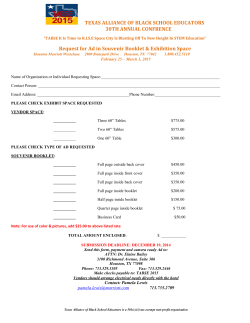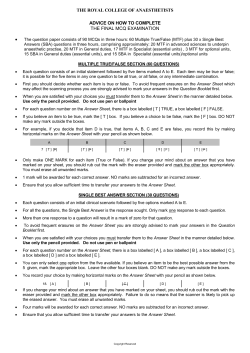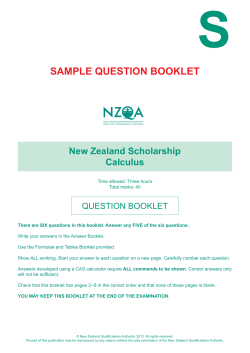
J 7109 PAPER III.p65
Signature and Name of Invigilator Roll No. (In figures as per admission card) 1. (Signature) (Name) Roll No. 2. (Signature) (In words) (Name) Test Booklet No. J7 1 0 9 Time : 2½ hours] PAPERIII FOLK LITERATURE Number of Pages in this Booklet : 32 [Maximum Marks : 200 Number of Questions in this Booklet : 26 Instructions for the Candidates ¬⁄UˡÊÊÁÕ¸ÿÙ¢ ∑§ Á‹U∞ ÁŸŒ¸‡Ê 1. Write your roll number in the space provided on the top of this page. 2. Answers to short answer/essay type questions are to be given in the space provided below each question or after the questions in the Test Booklet itself. 1. ¬„‹U ¬ÎDU ∑§ ™§¬⁄U ÁŸÿà SÕÊŸ ¬⁄U •¬ŸÊ ⁄UÙ‹U Ÿê’⁄U Á‹UÁπ∞– 2. ‹UÉÊÈ ¬˝‡Ÿ ÃÕÊ ÁŸ’¢œ ¬˝∑§Ê⁄U ∑§ ¬˝‡ŸÙ¢ ∑§ ©ûÊ⁄U, ¬˝àÿ∑§ ¬˝‡Ÿ ∑§ ŸËø ÿÊ ¬˝‡ŸÙ¢ ∑§ ’ÊŒ ◊¢ ÁŒÿ „Èÿ Á⁄UÄà SÕÊŸ ¬⁄U „Ë Á‹UÁπÿ– ß‚∑§ Á‹∞ ∑§Ù߸ •ÁÃÁ⁄UÄà ∑§Êª¡ ∑§Ê ©¬ÿÙª Ÿ„Ë¢ ∑§⁄UŸÊ „Ò– No Additional Sheets are to be used. 3. 3. At the commencement of examination, the question booklet will be given to you. In the first 5 minutes, you are requested to open the booklet and compulsorily examine it as below : ¬⁄UˡÊÊ ¬˝Ê⁄êU÷ „ÙŸ ¬⁄U, ¬˝‡Ÿ-¬ÈÁSÃ∑§Ê •Ê¬∑§Ù Œ ŒË ¡ÊÿªË– ¬„‹U ¬UÊ°ø Á◊Ÿ≈U •Ê¬∑§Ù ¬˝‡Ÿ-¬ÈÁSÃ∑§Ê πÙ‹Ÿ ÃÕÊ ©‚∑§Ë ÁŸêŸÁ‹Áπà ¡Ê°ø ∑§ Á‹U∞ ÁŒÿ ¡Êÿ¢ª Á¡‚∑§Ë ¡Ê°ø •Ê¬∑§Ù •fl‡ÿ ∑§⁄UŸË „Ò — (i) (i) To have access to the Test Booklet, tear off the paper seal on the edge of this cover page. Do not accept a booklet without sticker-seal and do not accept an open booklet. ¬˝‡Ÿ-¬ÈÁSÃ∑§Ê πÙ‹Ÿ ∑§ Á‹U∞ ©‚∑§ ∑§fl⁄U ¬¡§¬⁄U ‹UªË ‚Ë‹U ∑§Ù »§Ê«∏U ‹¢U– πÈ‹Ë „È߸ ÿÊ Á’ŸÊ S≈UË∑§⁄U-‚Ë‹U ∑§Ë ¬ÈÁSÃ∑§Ê SflË∑§Ê⁄U Ÿ ∑§⁄¢U– (ii) ∑§fl⁄U ¬ÎDU ¬⁄U ¿U¬ ÁŸŒ¸‡ÊÊŸÈ‚Ê⁄U ¬˝‡Ÿ-¬ÈÁSÃ∑§Ê ∑§ ¬ÎDU ÃÕÊ ¬˝‡ŸÙ¢ ∑§Ë ‚¢ÅÿÊ ∑§Ù •ë¿UË Ã⁄U„ øÒ∑§ ∑§⁄U ‹¢U Á∑§ ÿ ¬Í⁄U „Ò¢U– ŒÙ·¬Íáʸ ¬ÈÁSÃ∑§Ê Á¡Ÿ◊¢ ¬ÎDU / ¬˝‡Ÿ ∑§◊ „Ù¢ ÿÊ ŒÈ’Ê⁄UÊ •Ê ªÿ „Ù¢ ÿÊ ‚ËÁ⁄Uÿ‹U ◊¢ Ÿ „Ù¢ •Õʸà Á∑§‚Ë ÷Ë ¬˝∑§Ê⁄U ∑§Ë òÊÈÁ≈U¬Íáʸ ¬ÈÁSÃ∑§Ê SflË∑§Ê⁄U Ÿ ∑§⁄¢U ÃÕÊ ©‚Ë ‚◊ÿ ©‚ ‹Uı≈UÊ∑§⁄U ©‚∑§ SÕÊŸ ¬⁄U ŒÍ‚⁄UË ‚„Ë ¬˝‡Ÿ-¬ÈÁSÃ∑§Ê ‹ ‹– U ß‚∑§ Á‹∞ •Ê¬∑§Ù ¬Ê°ø Á◊Ÿ≈U ÁŒÿ ¡Êÿ¢ª– ©‚∑§ ’ÊŒ Ÿ ÃÙ •Ê¬∑§Ë ¬˝‡Ÿ-¬ÈÁSÃ∑§Ê flʬ‚ ‹Ë ¡ÊÿªË •ı⁄U Ÿ „Ë •Ê¬∑§Ù •ÁÃÁ⁄UQ§ ‚◊ÿ ÁŒÿÊ ¡ÊÿªÊ– (ii) Tally the number of pages and number of questions in the booklet with the information printed on the cover page. Faulty booklets due to pages/questions missing or duplicate or not in serial order or any other discrepancy should be got replaced immediately by a correct booklet from the invigilator within the period of 5 minutes. Afterwards, neither the question booklet will be replaced nor any extra time will be given. 4. •ãŒ⁄U ÁŒÿ ªÿ ÁŸŒ¸‡ÊÙ¢ ∑§Ù äÿÊŸ¬Ífl¸∑§ ¬…∏¢U– 5. One page is attached for Rough Work at the end of the booklet before the Evaluation Sheet. 5. ©UûÊ⁄U-¬ÈÁSÃ∑§Ê ∑§ •ãà ◊¢ ∑§ìÊÊ ∑§Ê◊ (Rough Work) ∑§⁄UŸ ∑§ Á‹∞ ◊ÍÀÿÊ¢∑§Ÿ ‡ÊË≈U ‚ ¬„‹ ∞∑§ ¬ÎDU ÁŒÿÊ „È•Ê „Ò– 6. If you write your name or put any mark on any part of the Answer Sheet, except for the space allotted for the relevant entries, which may disclose your identity, you will render yourself liable to disqualification. 6. ÿÁŒ •Ê¬ ©ûÊ⁄U-¬ÈÁSÃ∑§Ê ¬⁄U •¬ŸÊ ŸÊ◊ ÿÊ ∞‚Ê ∑§Ù߸ ÷Ë ÁŸ‡ÊÊŸ Á¡‚‚ •Ê¬∑§Ë ¬„øÊŸ „Ù ‚∑§, §Á∑§‚Ë ÷Ë ÷ʪ ¬⁄U Œ‡Êʸà ÿÊ •¢Á∑§Ã ∑§⁄Uà „Ò¢ ÃÙ ¬⁄UˡÊÊ ∑§ Á‹ÿ •ÿÙÇÿ ÉÊÙÁ·Ã ∑§⁄U ÁŒÿ ¡Êÿ¢ª– 4. Read instructions given inside carefully. 7. 7. You have to return the Test booklet to the invigilators at the end of the examination compulsorily and must not carry it with you outside the Examination Hall. •Ê¬∑§Ù ¬⁄UˡÊÊ ‚◊Ê# „ÙŸ §¬⁄U ©ûÊ⁄U-¬ÈÁSÃ∑§Ê ÁŸ⁄UˡÊ∑§ ◊„ÙŒÿ ∑§Ù ‹Uı≈UÊŸÊ •Êfl‡ÿ∑§ „Ò •ı⁄U ß‚ ¬⁄UˡÊÊ ‚◊ÊÁ# ∑§ ’ÊŒ •¬Ÿ ‚ÊÕ ¬⁄UˡÊÊ ÷flŸ ‚ ’Ê„⁄U Ÿ ‹∑§⁄U ¡UÊÿ¢– 8. ∑§fl‹ ŸË‹ / ∑§Ê‹ ’Ê‹U åflÊßZ≈U ¬ÒŸ ∑§Ê „Ë ßSÃ◊Ê‹ ∑§⁄¢U– 8. Use only Blue/Black Ball point pen. 9. Á∑§‚Ë ÷Ë ¬˝∑§Ê⁄U ∑§Ê ‚¢ªáÊ∑§ (∑Ò§‹∑ȧ‹≈U⁄U) UÿÊ ‹Êª ≈U’‹ •ÊÁŒ ∑§Ê ¬˝ÿÙª flÁ¡¸Ã „Ò– 9. Use of any calculator or log table etc. is prohibited. J7109 1 P.T.O. FOLK LITERATURE ‹Ê∑§ ‚ÊÁ„àÿ PAPERIII ¬˝‡Ÿ-¬òÊIII NOTE : This paper is of two hundred (200) marks containing four (4) sections. Candidates are required to attempt the questions contained in these sections according to the detailed instructions given therein. ŸÊ≈ — ÿ„ ¬˝‡Ÿ¬òÊ ŒÊ ‚ÊÒ (200) •¥∑§Ê¥ ∑§Ê „Ò ∞fl¥ ß‚◊¥ øÊ⁄ (4) 𥫠„Ò– •èÿÁÕ¸ÿÊ¥ ∑§Ê ߟ ◊¥ ‚◊ÊÁ„à ¬˝‡ŸÊ¥ ∑§Ê ©ûÊ⁄ •‹ª ÁŒÿ ªÿ ÁflSÃÎà ÁŸŒ¸‡ÊÊ¥ ∑§ •ŸÈ‚Ê⁄ ŒŸÊ „Ò– J7109 2 SECTION - I πá«UI Note : This section contains five (5) questions based on the following paragraph. Each question should be answered in about thirty (30) words and each carries five (5) marks. (5x5=25 marks) ŸÊ≈ — ß‚ 𥫠◊¥ ÁŸêŸÁ‹Áπà •ŸÈë¿Œ ¬⁄ •ÊœÊÁ⁄à ¬Ê°ø (5) ¬˝‡Ÿ „Ò¥– ¬˝àÿ∑§ ¬˝‡Ÿ ∑§Ê ©ûÊ⁄ ‹ª÷ª ÃË‚ (30) ‡ÊéŒÊ¥ ◊¥ •¬ÁˇÊà „Ò– ¬˝àÿ∑§ ¬˝‡Ÿ ¬Ê°ø (5) •¥∑§Ê¥ ∑§Ê „Ò– (5x5=25 •¥∑§) Read the passage below and answer the questions that follow based on your understanding of the passage : It is important to remember that the functions of the myth, legend, folktale, proverb, riddle, song and each of the other forms of folklore are to some extent distinctive and must be analyzed separately. As their very names suggest, this is also true of the various types of song : lullabies, love songs, war songs, work songs, ballads, blues religious songs, songs of praise and songs of ridicule or allusion. To fully understand folklore and its role in mens life we must have more knowledge of the specific functions of each of these forms in various societies, literate and nonliterate, and more of the tedious but extremely rewarding comparisons of the details of folklore text with those of culture and actual behaviour. It is only in this way that we may hope to explain rather than simply take for granted the fact that folklore is one of the human universals and perhaps to understand why the importance of folklore has decreased as the written and printed word have spread and mechanical devices such as Phonographs, radios moving pictures and television have been developed. ÁŒ∞ ª∞ •¥‡Ê ∑§Ê ¬Á…∏∞ ÃÕÊ ¬…∏∑§⁄U •¥‡Ê ∑§ •ÊœÊ⁄U ¬⁄U ÁŒ∞ ª∞ ¬˝‡ŸÊ¥ ∑§ ©ûÊ⁄U ŒËÁ¡∞– ß‚ ’Êà ∑§Ê ÿÊŒ ⁄UπŸÊ ◊„ûfl¬Íáʸ „Ò Á∑§ Á◊Õ, Œ¥Ã∑§ÕÊ, ‹Ê∑§ ∑§ÕÊ, ◊È„Êfl⁄U, ¬„‹Ë, ªËà ÃÕÊ ‹Ê∑§flÊÃʸ ∑§ •ãÿ M§¬ ∑ȧ¿U „Œ Ã∑§ •‹ª-•‹ª „Êà „Ò¥– ß‚Á‹∞ ©Ÿ∑§Ê Áfl‡‹·áÊ ÷Ë •‹ª-•‹ª Ã⁄U„ ‚ „ÊŸÊ øÊÁ„∞– ¡Ò‚Ê Á∑§ ©Ÿ∑§ ŸÊ◊Ê¥ ‚ S¬c≈U „Ò, ÿ„ ’Êà ÁflÁ÷ÛÊ ¬˝∑§Ê⁄U ∑§ ªËÃÊ¥ ¬⁄U ÷Ë ‹ÊªÍ „ÊÃË „Ò ¡Ò‚ Á∑§ ‹Ê⁄UË, ¬˝◊ªËÃ, ÿÈhªÊŸ, ÁR§ÿÊ-∑§‹Ê¬ ªËÃ, flË⁄UªÊÕÊ ªËÃ, ¬˝¥‡Ê‚Ê ∑§ œÊÁ◊¸∑§ ªËÃ, ©¬„Ê‚ ∑§ ÿÊ ‚¥∑§Ã ªËÖ ◊ÊŸfl ¡ËflŸ ◊¥ ‹Ê∑§flÊÃʸ ÃÕÊ ©‚∑§Ë ÷ÍÁ◊∑§Ê ∑§Ê ¬Í⁄UË Ã⁄U„ ‚ ‚◊¤ÊŸ ∑§ Á‹∞ „◊¥ ÁflÁ÷ÛÊ ‚◊ÈŒÊÿÊ¥-Á‡ÊÁˇÊà ÃÕÊ •Á‡ÊÁˇÊà - ◊¥ ߟ∑§ ¬˝àÿ∑§ M§¬Ê¥ ∑§ ¬˝∑§ÊÿÊZ ∑§Ê •ÊÒ⁄U •Áœ∑§ ôÊÊŸ „ÊŸÊ øÊÁ„∞– ‹Ê∑§flÊÃʸ ¬Ê∆UÊãÃ⁄UÊ¥ ∑§Ë •àÿãà ‹Ê÷ŒÊÿË ÃÈ‹ŸÊ ‚¥S∑ΧÁà ÃÕÊ flÊSÃÁfl∑§ √ÿfl„Ê⁄U ‚ ∑§Ë ¡ÊŸË øÊÁ„∞– ‹Ê∑§flÊÃʸ ◊ÊŸfl ‚Êfl¸÷ÊÒ◊Ê¥ ◊¥ ‚ ∞∑§ „Ò ÿ„ Ãâÿ ∑§fl‹ ◊ÊŸ ‹Ÿ ∑§Ë •¬ˇÊÊ „◊ ∑§fl‹ ß‚∑§Ë ß‚ Ã⁄U„ ‚ √ÿÊÅÿÊ ∑§⁄U ‚∑§Ã „Ò¥ ÃÕÊ ‚ê÷fl× ß‚‚ ‹Ê∑§flÊÃʸ ∑§Ë ◊„ûÊÊ ÄÿÊ¥ ∑§◊ „Ê ⁄U„Ë „Ò ß‚∑§ ’Ê⁄U ◊¥ ‚◊¤ÊÊ ¡Ê ‚∑§ÃÊ „Ò ÿlÁ¬ ¬„‹ ∑§Ë •¬ˇÊÊ Á‹Áπà ∞fl¥ ¬˝∑§ÊÁ‡Êà ‚ÊÁ„àÿ ∞fl¥ »§ÊŸÊª˝Ê»§, ⁄UÁ«UÿÊ, ◊ÍÁfl¥ª ø‹ÁøòÊ ÃÕÊ ŒÍ⁄UŒ‡Ê¸Ÿ ¡Ò‚Ë ÿÊ¥ÁòÊ∑§ ‚ÈÁflœÊ•Ê¥ ∑§Ê Áfl∑§Ê‚ „Ê ªÿÊ „Ò– J7109 3 P.T.O. 1. What is the impact of mass media on folklore ? »§Ê∑§‹Ê⁄U (‹Ê∑§flÊÃʸ) ∑§Ê ¡Ÿ ‚¥øÊ⁄U ◊Êäÿ◊Ê¥ ¬⁄U ÄÿÊ ¬˝÷Êfl „Ò? 2. Is it the inability of folklore to adapt itself to cultural change ? ÄÿÊ ‚Ê¥S∑ΧÁÃ∑§ ¬Á⁄UfløŸÊ¥ ∑§Ê Sfl× ª˝„áÊ Ÿ„Ë¥ ∑§⁄UŸÊ ÿ„ ‹Ê∑§flÊÃʸ ∑§Ë Áflfl‡ÊÃÊ „Ò? J7109 4 3. Is it taken for granted that folklore is one of the human universals ? ÿ„ ÄÿÊ¥ ◊ÊŸ Á‹ÿÊ ¡ÊÃÊ „Ò Á∑§ ‹Ê∑§flÊÃʸ ◊ÊŸfl ‚Êfl¸÷ÊÒ◊Ê¥ ◊¥ ‚ ∞∑§ „Ò? 4. Define the distinctiveness of the functions of folklore. ‹Ê∑§flÊÃʸ ∑§ ¬˝∑§ÊÿÊZ ◊¥ Á÷ãŸÃ⁄U ∑§Ë √ÿÊÅÿÊ ∑§ËÁ¡∞– J7109 5 P.T.O. 5. What is the role of specific functions of folk forms ? ‹Ê∑§ M§¬Ê¥ ∑§ ÁflÁ‡ÊC ¬˝∑§ÊÿÊZ ∑§Ë ÷ÍÁ◊∑§Ê ÄÿÊ „Ò? SECTION - II / πá«UII Note : This section contains fifteen (15) questions, each to be answered in about thirty (30) words. Each question carries five (5) marks. (5x15=75 marks) ŸÊ≈ — ß‚ 𥫠◊¥ ¬¥Œ˝„ (15) ¬˝‡Ÿ „Ò¥– ¬˝àÿ∑§ ¬˝‡Ÿ ∑§Ê ©ûÊ⁄ ‹ª÷ª ÃË‚ (30) ‡ÊéŒÊ¥ ◊¥ •¬ÁˇÊà „Ò– (5x15=75 •¥∑§) ¬˝àÿ∑§ ¬˝‡Ÿ ¬Ê°ø (5) •¥∑§Ê¥ ∑§Ê „Ò– 6. Define folk discourse. ‹Ê∑§-¬˝ÿÈÁQ§ ∑§Ë √ÿÊÅÿÊ ∑§ËÁ¡∞– J7109 6 7. What is meant by Nativism ? Œ‡ÊËflÊŒ (ŸÁ≈UflË¡◊) ‚ ÄÿÊ ÃÊà¬ÿ¸ „Ò? 8. What do you mean by repertory ? “‚¥ª˝„” ‚ •Ê¬ ÄÿÊ ‚◊¤Êà „Ò¥? J7109 7 P.T.O. 9. Give a brief account on the contribution of Devendra Satyarthi. ŒflãŒ˝ SÊàÿÊÕ˸ ∑§ ÿʪŒÊŸ ∑§ ’Ê⁄U ◊¥ ‚¥ˇÊ¬ ◊¥ ’ÃÊß∞– 10. What are the characteristics of folk epic hero ? ‹Ê∑§ ◊„Ê∑§Ê√ÿ (»§Ê∑§ •ÚÁ¬∑§) ∑§ ŸÊÿ∑§ ◊¥ ÄÿÊ-ÄÿÊ Áfl‡Ê·ÃÊ∞° „ÊÃË „Ò? J7109 8 11. What is a taletype ? ≈U‹-≈UÊ߬ (∑§ÕÊ ∑§Ê ¬˝∑§Ê⁄U) ‚ ÄÿÊ ÃÊà¬ÿ¸ „Ò? 12. What are the folk art forms ? ‹Ê∑§ ∑§‹Ê M§¬ ÄÿÊ-ÄÿÊ „Ò¥? J7109 9 P.T.O. 13. What is the difference between riddle and proverb ? ¬„‹Ë ÃÕÊ ◊È„Êfl⁄U ◊¥ ÄÿÊ •ãÃ⁄U „Ò? 14. What is meant by folk speech ? ‹Ê∑§ (S¬Ëø) ÷Ê·áÊ ∑§Ê ÄÿÊ •Õ¸ „Ò? J7109 10 15. Differentiate between folklore and fakelore. »§Ê∑§‹Ê⁄U ÃÕÊ »§∑§‹Ê⁄U ◊¥ •ãÃ⁄U S¬C ∑§ËÁ¡∞– 16. Define collective unconsciousness. ‚Ê◊ÈŒÊÁÿ∑§ •fløßÃÊ ∑§Ë √ÿÊÅÿÊ ∑§ËÁ¡∞– J7109 11 P.T.O. 17. Define the characteristics of folk literature. ‹Ê∑§‚ÊÁ„àÿ ∑§ ‹ˇÊáÊÊ¥ ∑§Ë √ÿÊÅÿÊ ∑§ËÁ¡∞– 18. Explain environmental ethics. ¬ÿʸfl⁄UáÊ ∞ÁÕÄ‚ (ŸÒÁÃ∑§ÃÊ) ∑§Ë √ÿÊÅÿÊ ∑§ËÁ¡∞– J7109 12 19. What is the cultural geography ? ‚Ê¥S∑ΧÁÃ∑§ ÷ͪʋ ÄÿÊ „Ò? 20. Define cultural identity. ‚Ê¥S∑ΧÁÃ∑§ •ÁS◊ÃÊ ∑§Ë √ÿÊÅÿÊ ∑§ËÁ¡∞– J7109 13 P.T.O. SECTION - III πá«UIII Note : This section contains five (5) questions of twelve (12) marks each. Each question is to be answered in about 200 words. (12x5=60 marks) ŸÊ≈ — ß‚ π¢«U ◊¥ ’Ê⁄U„U (vw) •¢∑§Ù¥ ∑§ ¬Ê°ø (z) ¬˝‡Ÿ „Ò¥U – ¬˝àÿ∑§ ¬˝‡Ÿ ∑§Ê ©UûÊ⁄U ‹ª÷ª ŒÙ ‚ı (wÆÆ) ‡ÊéŒÙ¥ ◊¥ •¬ÁˇÊà „ÒU – 21. (12x5=60 •¥∑§) Explain how folklore manifests the world view of a particular people. »§Ê∑§‹Ê⁄U(‹Ê∑§flÊÃʸ) Á∑§‚ ¬˝∑§Ê⁄U ÁflÁ‡Êc≈U ‹ÊªÊ¥ ∑§ Áfl‡fl√ÿÊ¬Ë ŒÎÁC∑§ÊáÊ ∑§Ê √ÿÄà ∑§⁄UÃË „Ò? √ÿÊÅÿÊ ∑§ËÁ¡∞– 22. How folklore has been absorbed by the popular culture today ? •Ê¡∑§‹ ‹Ê∑§flÊÃʸ ¬˝øÁ‹Ã ‚¥S∑ΧÁà ∑§Ê ∑§Ò‚ ‚◊ÊÁ„à ∑§⁄UÃË „Ò? 23. Give your views on the survival and continuity of folklore. ‹Ê∑§flÊÃʸ ∑§Ë ¡ËÁflÃÊ (‚⁄UflÊ߸fl‹) ÃÕÊ ÁŸ⁄UãÃ⁄UÃÊ ∑§ ’Ê⁄U ◊¥ •¬Ÿ ÁfløÊ⁄U √ÿQ§ ∑§ËÁ¡∞– 24. How to use of folklore as historical source. ∞ÁÄÊÁ‚∑§ dÊà ∑§ M§¬ ◊¥ ‹Ê∑§flÊÃʸ ∑§Ê ∑Ò§‚ ¬˝ÿʪ Á∑§ÿÊ ¡Ê∞ªÊ? 25. Do you agree that folkloristics is an interdisciplinary in nature ? Illustrate your views. ‹Ê∑§flÊÁø∑§Ë ∑§Ë ¬˝∑ΧÁà ◊¥ •¥Ã—‡ÊÊSòÊËÿ •ŸÈ‡ÊÊ‚Ÿ „Ò– ÄÿÊ •Ê¬ ß‚‚ ‚„◊à „Ò¥? •¬Ÿ ÁfløÊ⁄U √ÿÄà ∑§ËÁ¡∞– J7109 14 J7109 15 P.T.O. J7109 16 J7109 17 P.T.O. J7109 18 J7109 19 P.T.O. J7109 20 J7109 21 P.T.O. J7109 22 J7109 23 P.T.O. SECTION - IV πá«IV Note : This section consists of one essay type question of forty (40) marks to be answered in about one thousand (1000) words on any one of the following topics. (40x1=40 marks) ŸÊ≈ — ß‚ 𥫠◊¥ ∞∑§ øÊ‹Ë‚ (40) •¥∑§Ê ∑§Ê ÁŸ’ãœÊà◊∑§ ¬˝‡Ÿ „Ò Á¡‚∑§Ê ©ûÊ⁄ ÁŸêŸÁ‹Áπà Áfl·ÿÊ¥ ◊¥ ‚ ∑§fl‹ ∞∑§ ¬⁄, ‹ª÷ª ∞∑§ „¡Ê⁄ (1000) ‡ÊéŒÊ¥ ◊¥ •¬ÁˇÊà „Ò– (40x1=40 26. •¥∑§) Discuss how folklore has been applied in various kinds of mass media in the current cultural scenerio. flø◊ÊŸ ‚Ê¥S∑ΧÁÃ∑§ ¬Á⁄U¬˝ˇÿ ◊¥ ÁflÁ÷ÛÊ ¬˝∑§Ê⁄U ∑§ ¡Ÿ-‚¥øÊ⁄U ◊Êäÿ◊Ê¥ ◊¥ ‹Ê∑§flÊÃʸ ∑§Ê Á∑§‚ ¬˝∑§Ê⁄U ¬˝ÿʪ Á∑§ÿÊ ¡ÊÃÊ „Ò? øøʸ ∑§ËÁ¡∞– OR / •ÕflÊ Which theory of folklore is more relevant and significant ? Give justification. ‹Ê∑§flÊÃʸ ∑§Ê ∑§ÊÒŸ ‚Ê Á‚hÊãà ‚’‚ •Áœ∑§ ¬˝Ê¥‚Áª∑§ ÃÕÊ ◊„àfl¬Íáʸ „Ò? Ã∑§¸ ‚Á„à Á‚h ∑§ËÁ¡∞– OR / •ÕflÊ Give an outline of folklore research in various States of India. ‹Ê∑§flÊÃʸ ∑§ ˇÊòÊ ◊¥ ÷Ê⁄Uà ∑§ ÁflÁ÷ÛÊ ⁄UÊíÿÊ¥ ◊¥ „ÊŸflÊ‹ ‡ÊÊœ-∑§Êÿ¸ ∑§Ë M§¬⁄UπÊ ŒËÁ¡∞– J7109 24 J7109 25 P.T.O. J7109 26 J7109 27 P.T.O. J7109 28 J7109 29 P.T.O. J7109 30 J7109 31 P.T.O. FOR OFFICE USE ONLY 1 26 51 76 2 27 52 77 3 28 53 78 4 29 54 79 5 30 55 80 6 31 56 81 7 32 57 82 8 33 58 83 9 34 59 84 10 35 60 85 11 36 61 86 12 37 62 87 13 38 63 88 14 39 64 89 15 40 65 90 16 41 66 91 17 42 67 92 18 43 68 93 19 44 69 94 20 45 70 95 21 46 71 96 22 47 72 97 23 48 73 98 24 49 74 99 25 50 75 100 Marks Obtained Question Number Marks Obtained Question Number Marks Obtained Question Number Marks Obtained Question Number Marks Obtained Total Marks Obtained (in words) ..................................... (in figures) .................................... Signature & Name of the Coordinator ............................... (Evaluation) J7109 Date ............................. 32
© Copyright 2024









